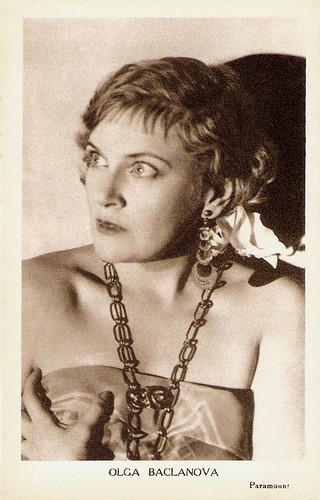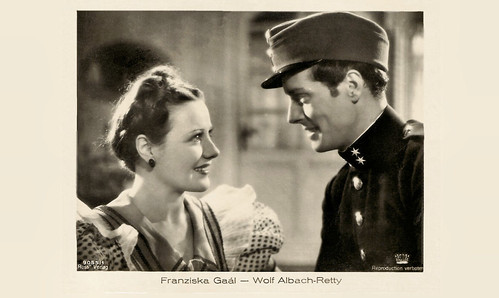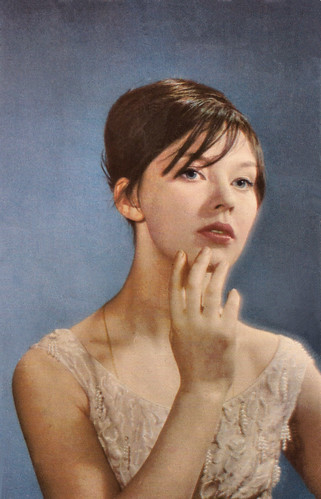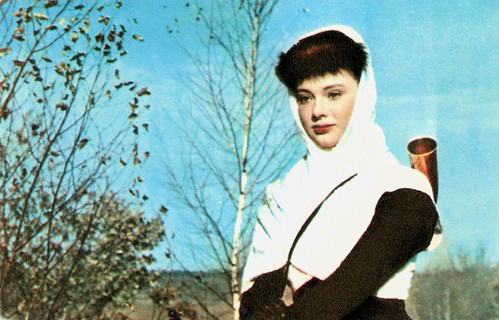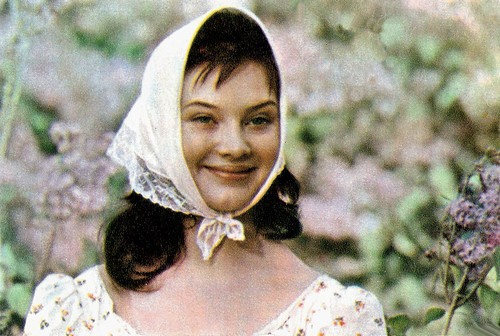Beata Tyszkiewicz (1938) is one of Poland’s quintessential film beauties and she is referred to as 'the First lady of the Polish cinema'. Exclusively working for the cinema, she appeared in more than 100 films.
East-German postcard by VEB Progress Film-Vertrieb, Berlin, no. 190/69, 1969. Retail price: 0,20 MDN.

East-German postcard by VEB Progress Film-Vertrieb, Berlin, no. 176/70, 1970. Retail price: 0,20 MDN. Photo: Linke.
Distinguished Ladies
Beata Maria Helena Tyszkiewiczówna-Kalenicka was born in Wilanów, Poland in 1938. She has aristocratic roots. Her father was Count (in Polish Hrabia) Krzysztof Maria Tyszkiewicz and her mother was Barbara Rechowicz.
At 16, Beata made her film debut in Zemsta/The Revenge (1956, Antoni Bohdziewicz, Bohdan Korzeniewski), based on the classic play by Aleksander Fredro. She was still going to school at the time.
In the years 1957-1958 she studied at the Warsaw Academy of Dramatic Arts, and then worked for TV.
She played a supporting part in Samson (Andrzej Wajda, 1961), set in the Warsaw ghetto during World War II. The famous director would become her first husband.
During the 1960s, she became well-known through her portrayal of distinguished ladies in costume dramas like Wojciech Has’ Rekopis znaleziony w Saragossie/The Saragossa Manuscript (1965) starring Zbigniew Cybulski, and Lalka/The Doll (1968). The Doll was adapted from the Polish novel, Lalka by Boleslaw Prus.
She played a princess in her husband’s Western-style war epic Popioly/The Ashes (Andrzej Wajda, 1965) with Daniel Olbrychski, and later played in his Pszystko na sprzedaz/Everything for Sale (Andrzej Wajda, 1969). The latter was filmed in memory of Zbigniew Cybulski who was killed the previous year by a moving train. The star died tragically at the peak of his career, just like the ‘invisible’ and much-talked-about protagonist of the film.
Tyszkiewicz went to work abroad and appeared in Belgium in the drama De man die zijn haar kort liet knippen/The Man Who Had His Hair Cut Short (André Delvaux, 1969) featuring Senne Rouffaer, and in Russia in Dvoryanskoe gnezdo/A Nest of Gentry (Andrey Konchalovskiy, 1969), based on a novel by Ivan Turgenev.
East-German postcard by VEB Progress Film-Vertrieb, Berlin, no. 2965. Retail price: 0,20 MDN.

Big East-German card by VEB Progress Film-Vertrieb, Berlin, no. 127/71, 1971. Retail price: 0,50 MDN.
A Humorous, Male-fantasy Set After A Mythical World War III
During her career, Beata Tyszkiewicz has appeared in more than 100 films. She worked with such leading directors as Márta Mészáros on Útközben/On the Move (1979) with Delphine Seyrig, and Krzysztof Zanussi at Kontrakt (1980) starring Leslie Caron.
On TV she was seen in the popular war series Polskie drogi/Polish Fates (Janusz Morgenstern, 1976). The series shows the different reactions of Polish people to the Nazi invasion of Germany in 1939 and to the later occupation.
In France she played in the biopic Édith et Marcel/Edith and Marcel (Claude Lelouch, 1983) about the ill-fated romance of boxing champion Marcel Cerdan and singer Édith Piaf.
A huge success was the Polish Sci-Fi film Seksmisja/Sex Mission (Juliusz Machulski, 1984). Eleanor Mannikka at AllMovie: “Co-writer and director Juliusz Machulski has come up with a hybrid sex sci fi comedy that defies categorization - a humorous, male-fantasy that is set after a mythical World War III, in a surviving underground world of women only. Before the terrible onslaught of the final war, two scientists were frozen in a state of suspended animation with the intention of thawing them out in three years. When they are released from their ice-bound sleep, 50 years have passed instead and they find themselves the only two males in a female society that has thus far reproduced only in the test tube.”
Other successes were the comedies Vabank II czyli riposta/ Point of No Return (Juliusz Machulski, 1985), and Kingsajz/King Size (Juliusz Machulski, 1988) with Jerzy Stuhr.
Tyszkiewicz appeared in international films and TV-series, including 30 Door Key (Jerzy Skolimowski, 1991) starring Iain Glen, and La petite apocalypse/The Little Apocalypse (Costa-Gravas, 1993).
In 1998 she received her star on Aleja Gwiazd(Stars Avenue) in Łódź. Although the reputation of the Polish cinema diminished since then, she kept working steadily in films and TV series. On TV, she is a jury member on Poland's Dancing with the Stars (aka Taniec z gwiazdami).
She has two daughters: actress and assistant director Karolina Wajda (1967), and actress Wiktoria Padlewska (1977) with her second husband Jacek Padlewski. Her third husband was Witold Orzechowski.
Lately, Beata Tyszkiewicz was seen in the popular romantic comedy Listy do M./Letters to Santa (Mitja Okorn, 2011) and the comedy 100dniówk@ (Alessandro Leone, 2013) with her old colleague Daniel Olbrychski.
American trailer for Rekopis znaleziony w Saragossie/The Saragossa Manuscript (1965). Source: Mindfuckarchives (YouTube).
A scene from De man die zijn haar kort liet knippen/The Man Who Had His Hair Cut Short (1966), with Senne Rouffaer and Beata Tyszkiewicz. Source: Zaychatina (YouTube).
German trailer for Seksmisja/Sex Mission (1984). Source: Rami8184 (YouTube).




















